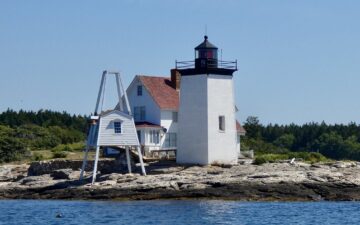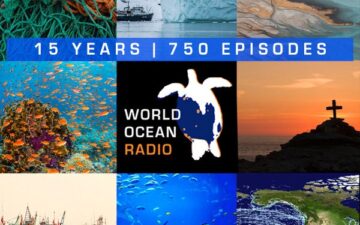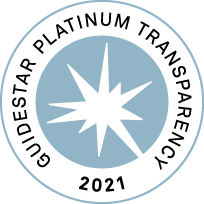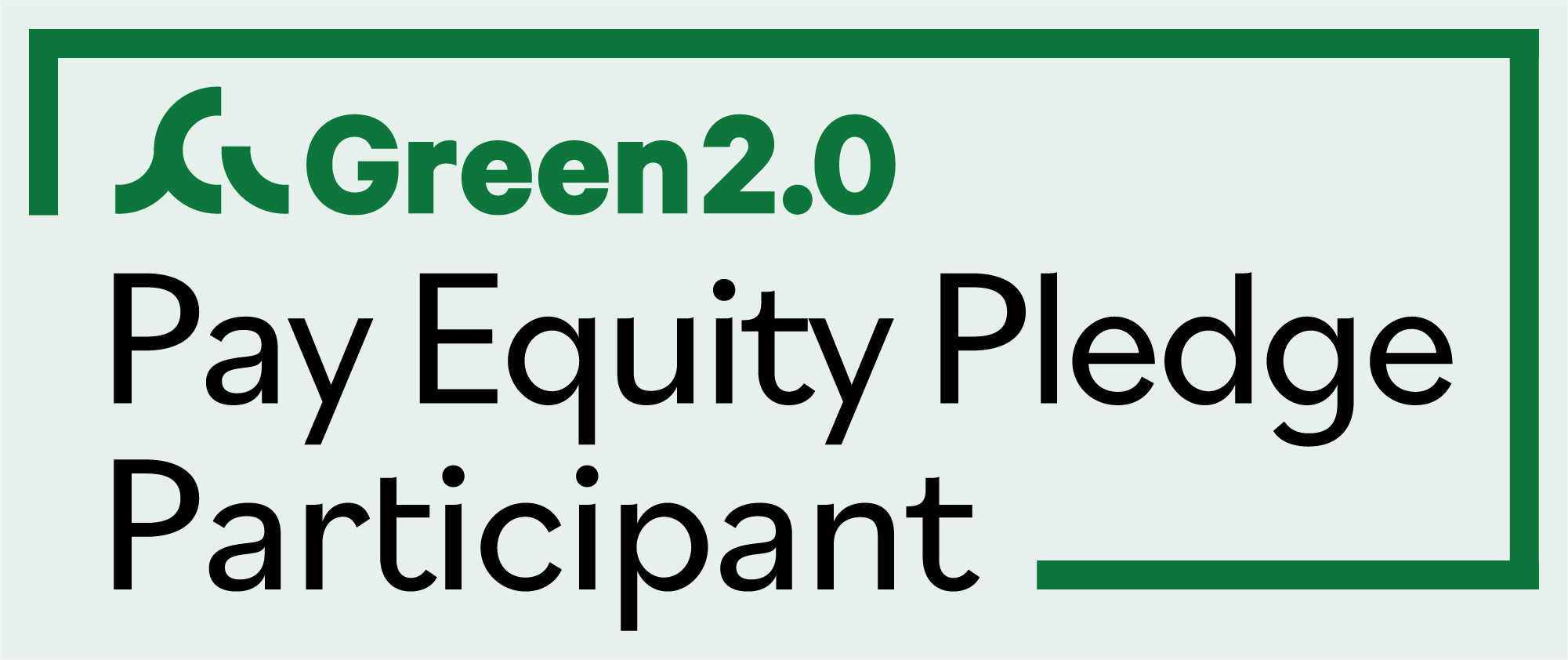[Adapted from a keynote given for “Oceans of Knowledge” at the Royal Institution hosted by the Institute of Marine Engineering, Science & Technology on November 20, 2019]
Investment in and dependence on the ocean economy is nearly as old as humankind itself. So why are we talking as if there’s something new? Why are we using the phrase “the blue economy”? Why do we think there is a new growth opportunity from a “blue economy”? And what do we mean when we talk about the “new blue economy”? The ocean economy has always existed for transport and trade, resource extraction, and sadly for waste disposal (both intentional and unintentional). Even before human settlements, the ocean transported resources such as animals, plants, and seeds powered by wind, current, and tide.
Humans took to the sea early. The ocean economy got its start with the harvest of nearshore animals and plants for subsistence. Shortly after, the first fishermen left shore in rafts or boats in search of more catch. Over time, fishermen began to stop fishing solely for subsistence and began to trade. The first evidence of maritime trade dates back to 2000 BCE in the Indian Ocean. International trade continued to be commonplace at the regional level for millennia and grew steadily as advances in shipbuilding and navigation enabled seafaring across greater distances and further from land. By the first century, the maritime “silk road” trade had been established and trade was thriving between ports in Asia, Africa, and Europe. Centuries later, the Roman Empire’s navy was instrumental in its conquests and it sustained the Empire through maritime trade. Every empire since, including the British, Dutch, Portuguese, Spanish, and others, has depended upon maritime trade for both its survival and its fortunes.
Early on, governments recognized the revenue potential of landed goods, goods that came into port from another location, and thus, import duties were imposed. When the import taxes were introduced, so too began the time-honored maritime industry of smuggling. In an effort to expand their sources of raw materials and find new markets, governments invested in exploratory voyages. Some famous examples of the explorers leading these voyages are Christopher Columbus and John Cabot, who sailed in the 15th century for the governments of Spain and England respectively. Neither ever made it to their intended destination of China, but instead ended up in the Americas, which greatly benefited the governments each represented.
By early in the 16th century, the French fishermen were catching cod on the coast of Newfoundland in the summers, drying their catch, then transporting it back to France in the fall. The Spanish had colonized much of the Caribbean and part of North & South America. In its early stages, what would become the Portuguese empire was already building a far-flung network of colonies providing raw materials, goods, and markets from Indonesia to Brazil to Angola. By the mid 17th century, international trade was global, conducted by high speed, sustainably powered Spanish galleons, Dutch fluyts, and other merchant ships from every coastal European nation (all built of natural materials by the way). It was the beginning of an era, a time when trade was global and the ocean economy thriving, but still at a scale that was relatively sustainable from a consumption standpoint, even if imperialism was socially rather unsustainable and irresponsible.
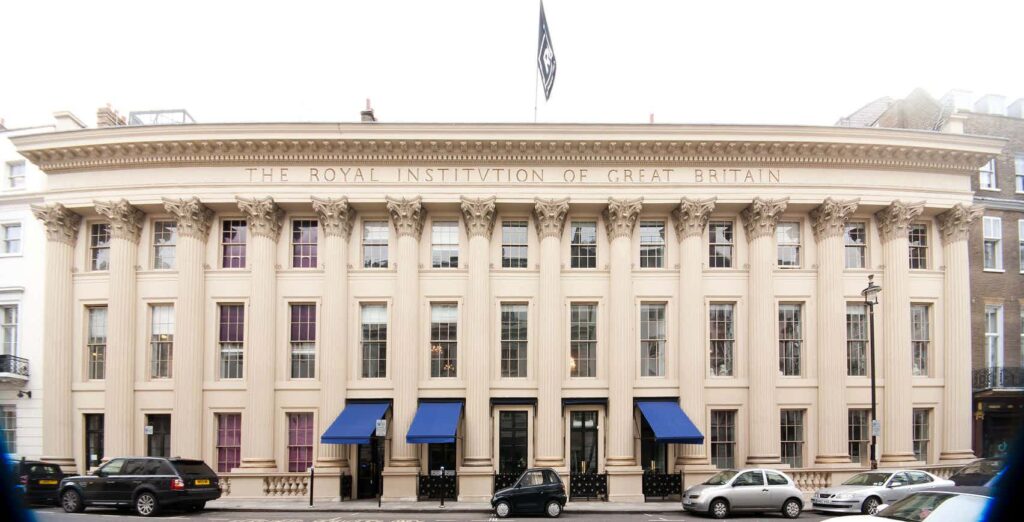
Empires depended on the appropriation of natural resources from colonized and subjugated countries, the production and transport of crops, the transport and ultimately sale of labor to acquire those resources, and the accompanying trade in consumer goods. Maritime activities such as, military, mercantile, and fishing (including whaling), were the means by which empires enforced and enriched themselves.
As trans-ocean trade expanded, governments carried most of the financial risk until investing in shares of merchant ship cargos became a very attractive private gamble. In 1636, Lloyds of London was established to do just that. The fortunes of investors, speculators, and the nascent insurance industry were all built from participation in the international ocean trade in tobacco, alcohol, textiles, chinaware, spices, whale oil, precious metals, and enslaved peoples. In turn, the trade permitted the exchange of ideas and information that sparked innovations in all fields of science and technology. International trade did have negative effects too. Increased international trade aided the spread of invasive species and various diseases, incentivized human trafficking, and, in some areas, changed animal behavior, distribution, and population.
At the onset of the Industrial Revolution, manufacturing could not have increased in scale through mechanization without various oils from marine animals, especially spermaceti oil used to lubricate machines. With the Industrial Revolution flourishing, we saw the beginnings of the over-exploitation of the ocean at a global scale. The steady increase in extraction of resources and other activities, enabled by the advent of steam engines and ships powered by coal and oil, and ultimately the fossil fuel-dependent global economy, was empowered by the belief that the ocean’s resources were infinite.
Historically, human activities were based on the false premise that the ocean was limitless in its capacity to provide for and sustain us, as well as to absorb the byproducts of our economies – waste in every form. Over the past few decades, we have seen the cost of that myth in the quantity, pace, and rate of change we are observing in the ocean that will affect all of the ocean economy.
The ocean is becoming more and more unpredictable in a plethora of ways. Since the Industrial Revolution, the ocean has become 30% more acidic and continues to acidify at an unprecedented rate. New climate and weather variability will continue to affect transportation methods of all kinds for at least the next century, disrupting the relatively stable patterns on which commerce depends. Just about a third of the human population lives within 100 km of a coastline and thus is already being affected by sea-level rise and storm surges, which we know will get much worse. Warming water is changing fish distribution and the viability of aquaculture, which threatens the economies of fishing communities. Harmful algal blooms are occurring with greater frequency and have longer duration—affecting human and marine animal health—and in turn, affecting coastal economies. Similarly, because of nutrient loading and warmer waters, low oxygen areas in the ocean are increasing in intensity, duration, and volume, depleting fish populations and affecting food webs.
The ocean is simply not what it was even 60 years ago, and certainly not what it was 250 years ago. The historic calculation of the traditional ocean economy and what the ocean does for us did not measure what the ocean actually does for us. After millennia of exploitation, perhaps it’s time that it did.
So, what is it that the ocean does for us? The ocean generates economic values that can be hard to quantify; after all, what is the dollar value of every other breath we take? How do we calculate the value of climate and temperature regulation, oxygen generation, and carbon emission absorption? How do we calculate the value of its pollution filtration and waste processing? How do we calculate the ocean’s cultural value, aesthetics, recreation, fun, and inspiration?
Of these, we only quantify direct economic activity, with little consideration of the unseen cost of those activities, and we ignore the benefits of the rest. However, quantifying these benefits is not necessary, as long as we acknowledge them. We only need to agree that these ocean-generated values are threatened by cumulating human activities. The scientific studies released in the fall of 2019 confirm that the harm already done is much worse than we thought. These human-generated harms are numerous including, CO2 emissions, overfishing and by-catch, noise pollution from shipping, hypoxia from deoxygenation, plastic pollution loading, minerals and petroleum extraction, harmful algal blooms exacerbated by nutrient loading, and the destruction of coastal wetlands, mangroves, seagrass, and tropical and deep, cold-water coral.
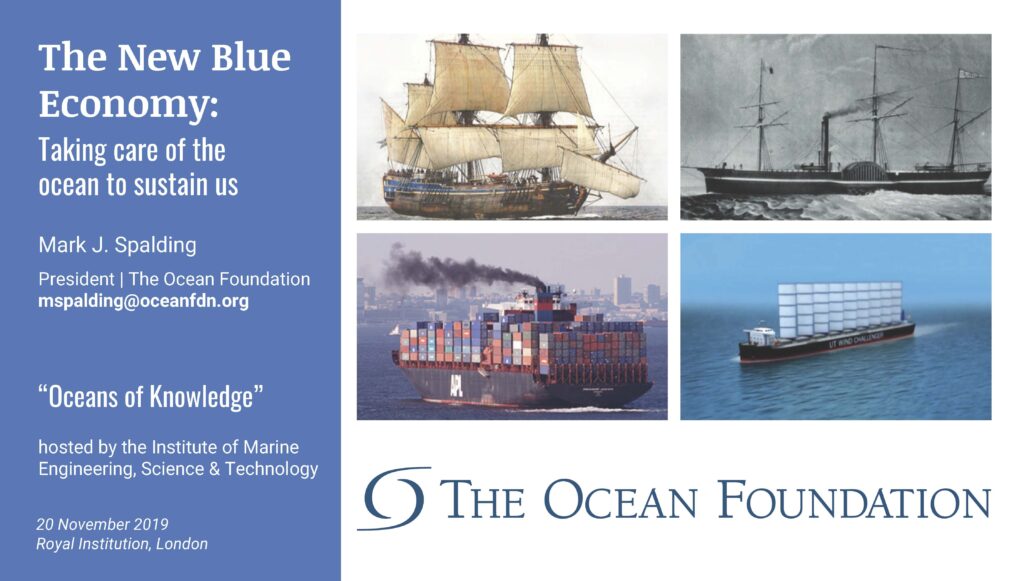
However, we can summarize what is wrong in two sentences. We take too much good stuff out of the ocean. We put too much bad stuff into the ocean. This trend must stop. We must restore our ocean’s abundance and repair the harm where we can. We can begin by shifting our focus to the subset within the ocean economy that is sustainable. With that, ensuring that the economic and related losses resulting from unsustainable use (and abuse) of coastal and marine resources must be captured in any economic risk assessments.
In 2016, 193 countries committed to the United Nations Sustainable Development Goals (SDGs) in support of a new blue economy that take into consideration how future generations will be affected by today’s resources management. Of the total seventeen SDGs, SDG14 established the need to “Conserve and Sustainably Use the Oceans, Seas and Marine Resources for Sustainable Development,” and directly supports 10 of the other 16 SDGs including the ones to end poverty and hunger.
To fulfill SDG14, we need to grow that subset of the entire ocean economy that is sustainable. Such an effort moves us away from destructive extraction-focused business sectors that deplete our ocean resources, disrupt its functions, damage our economy, and cost people their jobs. This is what Dr. Jane Lubchenco calls moving from the Ocean 1.0 narrative that the ocean was “too big to fail” to the Ocean 3.0 narrative, “too big to ignore.” Thus, we need to live as though climate change is real and that we can do something about it.
The new blue economy is about taking control, and not giving up sustainability. The “old” ocean economy needs to be brought up to new 21st century standards that acknowledge the vulnerability of global ocean health and our dependence on restoring it. Examples of the “old” ocean economy include offshore oil and gas extraction, recreational and commercial fishing, open-pen aquaculture, shipping, coastal development, and telecommunications.
Some parts of the old ocean economy are evolving toward sustainability or could with the right investment. For example, technology advances enabled better monitoring and understanding of the economics of high seas fishing, which takes place in the 2/3 of our ocean that lies outside of any national jurisdiction. A 2018 study showed that such fishing is wildly unprofitable without significant government subsidies (many of which are illegal). Given the environmental harm and dubious human rights record of high seas fishing, ending all government fleet subsidies would limit the fishing effort to that which is profitable and thus, increase abundance.
From the perspective of its carbon footprint by weight and distance, shipping is the best way to move goods, but the industry has to embrace and adopt clean fuel, clean air and noise reduction technologies, and perhaps this is where the illegal fishing subsidies should be lawfully re-invested. There are new industrial sectors reflecting the changes in the ocean economy such as renewable ocean energy, seabed mining, nature-based solutions (restoration and protection of blue carbon), blue technology and biotechnology, and nutrition and nutraceuticals. These emerging sectors, some still extractive (such as seabed mining) and some focused on change (such new ideas about ship propulsion) need to be assessed for their value to the new blue economy. Each of these can tap into existing science and technology and take advantage of applied knowledge to support positive activities and limit negative consequences.

In this pursuit, my friend Alexandra Cousteau suggests that abundance has to be our collective end goal. That means establishing positive ridge-to-reef and land-to-sea activities. It means minimizing the harm from human activity to allow ocean ecosystems to heal themselves. It means governance has to anticipate potential change in what is abundant and create the most hospitable waters for abundance. This requires investment in healthy mangroves, seagrass meadows, and marshes; as well as waterways that are clean and trash free.
Abundance and biomass should be the focus of revitalization efforts in order to keep up with population growth and to support the economy as well. This is not about choosing conservation protections versus the economy. Conservation, protection, enforcement, and preservation are good, they work, and they support economic activity. But we cannot just maintain where we are in the face of increasing demands with rapidly changing conditions. We cannot call it conservation if we continue to allow nutrients and other pollutants to flow unchecked into the sea. Abundance has to be our goal for food security and healthy ecosystems, this will allow us to get ahead of population growth and the ever-increasing demands on all resources. Our priority has to change from “hold the line” to “restore abundance” and should engage all interested parties who want to work for a healthy and profitable future.
Developing the new blue economy requires a wide range of partners including on-the-ground NGOs, scientists researching sustainability and ecosystem services, lawyers defining its terms, experts seeking to apply new technologies to monitoring and solutions, financial and philanthropic institutions helping to bring the economic models and financing to bear, and by working directly with local economic, natural, and environmental ministries, agencies, and departments. These many partners are identifying the leading sectors where smart investment can ensure that natural infrastructure and resilience are secure to guarantee clean air and water, climate and community resiliency, healthy food, access to nature, and progress towards restoring the abundance our children and grandchildren will need.
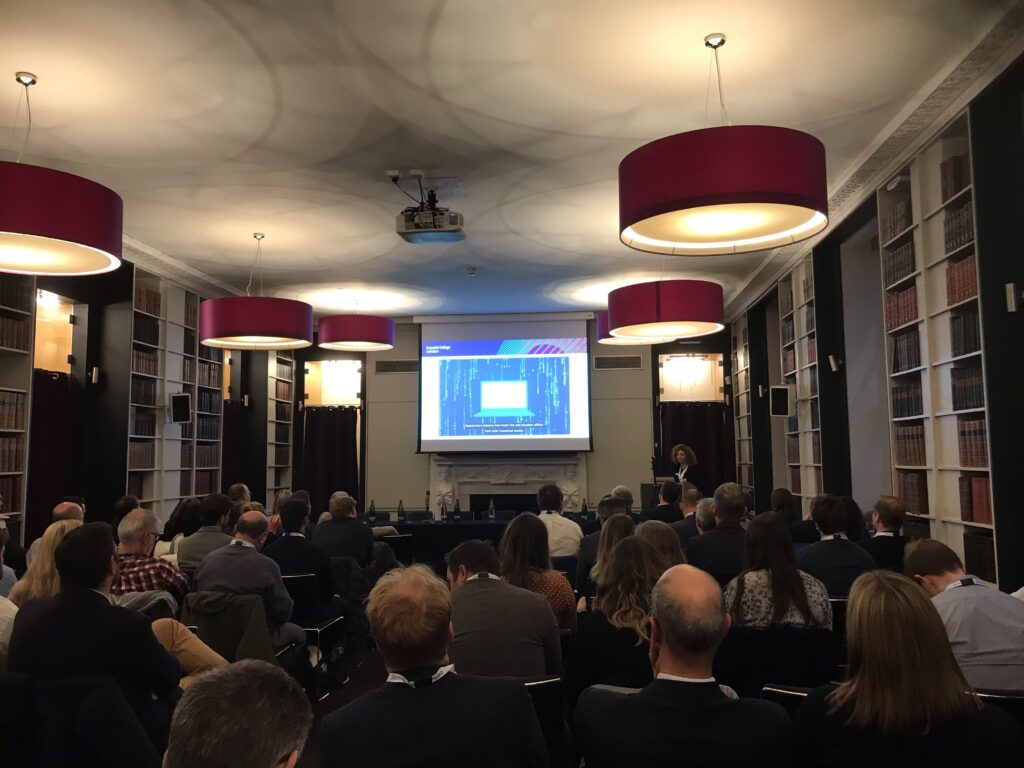
The world’s coasts and ocean are a valuable and delicate part of our natural capital, but the “take it all now, forget about the future” business-as-usual model of the current economy is threatening not only marine ecosystems and coastal communities, but the functions of our planet on which all life depends. The ocean is not too big to fix. We cannot afford to let it fail. The planet will be here even if the ocean is hot, breathless, and acidic. But such a place will not be our blue planet. Our blue planet is what the new blue economy is all about.
To get to the new blue economy, we need to incorporate the value of ocean and coastal ecosystems and services into our mindsets around security, economy, and global health. All nations’ blue economies are connected. We need to make sure that every ocean-going country improves their standing on the Global Illicit Trade Environment Index (a measure of how well countries prevent or enable illicit trade) because illicit activities are one significant obstacle in the path of the new blue economy. Other obstacles must also be addressed, including inertia, old-ocean economy thinking, and the insistence on having all the answers before we act.

We need to recognize that restoration, protection, and enforcement are all economic activities that underpin other parts of our economies and security. Policy agendas must be developed that simultaneously enhance ocean health and economic growth, in a manner consistent with principles of social equity, inclusion, and justice. Agendas that work toward improvement of human wellbeing and social equity, while also mitigating environmental risks and ecological scarcities, are agendas that support economic well-being. We need to overcome the lack of political will to do the right thing whether it’s from government or industry. There are some intentional misunderstanding of the blue economy that must be reversed, mainly that growth for the sake of growth is not sustainable and there will be no new blue economy if we keep taking too much good stuff out of the ocean and dumping too much bad stuff in.
To get back to abundance we must first understand that restoring abundance does not mean subsidizing bad behavior. We need to become infinitely more precautionary in setting baselines from which to measure progress.
Second, we know that there is an internal rate of return (for finance) if biomass recovers. We need to ensure that the economic measures to value a project are based on whole systems thinking. However, as with pharmaceuticals and other deep research and development industries, the costs are upfront, and returns are certainly not very immediate. So, how do you invest in and lower risk on ecosystem services? Both direct and indirect methods of investment must be pursued. For example, this might mean protecting a reef or restoring mangroves, and doing upstream sewage and pollution management so that the progress downstream is not upended upstream. Sovereign governments must invest in early stages of research and development to get technology to investment grade, which is how we got GPS, the internet, touch screens, and the microchip.
Innovation need to be incentivized to meet growing needs. One priority is the monitoring and tracking sector to understand ocean processes and prevent infrastructure failure, among other applications. Other priorities include clean waste-to-energy processes to reduce at-risk landfills, increase the value of beaches, and increase small island energy independence; sea water air conditioning via heat exchangers; and ocean thermal energy conversion, as well as more traditional renewable energy. In the right policy atmosphere, these investments are attractive. We can create that.
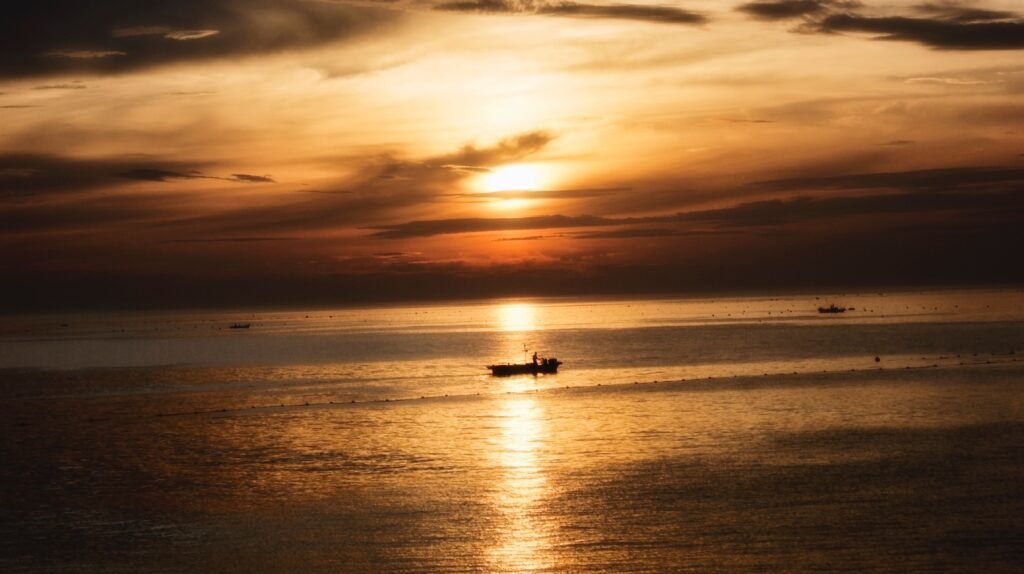
The Ocean Foundation (TOF) is dedicated to identifying and investing in those activities that comprise a new blue economy. We envision a day when we measure activities by whether they are good for the ocean and understand that “good for the ocean” means good for all of us. TOF and the Center for Blue Economy are working to facilitate multinational agreement on the identification of the new blue economy via mutually agreed criteria, industry classification codes, and so on. TOF is also a part of the Advisory Network for the High-Level Panel for a Sustainable Ocean Economy, and we haven’t ignored the markets. Over more than seven years, we reviewed thousands of companies looking for products and services that are “actively good for the ocean,” figuring that it might be good for the bottom line too. Then we went looking for a visionary investment partner, which we found in Rockefeller Capital Management—a company that already had a track record for investment quality and screening companies using standard CSR/ESG criteria.
In 2012 we co-launched the Rockefeller Ocean Strategy, as an international, all cap, fund with active, long-only publicly traded securities. To keep the fund’s investments “actively good for the ocean,” TOF screens each company and provides Rockefeller Capital Management specialized insight and research on coastal and ocean trends, risks, and opportunities. Our investment hypothesis for the strategy has been confirmed by its strong performance. Meaning what is good for the ocean is good for all of us. We are now moving to increase funds under management to $1b with a broader focus. This “unprecedented ocean-centric investment fund” is housed in the family office of a famous oil baron whose family is now fully divested of all oil and gas holdings. Change is possible.
Institutions that help us do better – monitoring, enforcing, restoring—are integral to the future abundance of our ocean. So, I am calling on you to invest in research and development, accelerators, incubators, and in companies that have a product or service that is actively good for the ocean. The subset of the entire ocean economy that is sustainable because it will make profits, help investors earn income, and contribute to a new bottom line… a healthier ocean.
This text was adapted from a keynote given for “Oceans of Knowledge” at the Royal Institution hosted by the Institute of Marine Engineering, Science & Technology on November 20, 2019.

